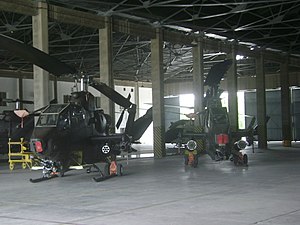This article needs additional citations for verification. (June 2012) |
| Fourth Balochistan Conflict | |||||||
|---|---|---|---|---|---|---|---|
| Part of the Insurgency in Balochistan and the Cold War | |||||||
 Pakistan Army Attack Helicopters HueyCobra AH-1S Cobras at AVN Base, Multan. | |||||||
| |||||||
| Belligerents | |||||||
|
|
| ||||||
| Commanders and leaders | |||||||
|
Armed by: Post-combat: |
| ||||||
| Strength | |||||||
|
80,000 (Initial) 145,000 |
20,000 (Initial) | ||||||
| Casualties and losses | |||||||
| ~3,000 casualties (including injured and killed)[4] | ~5,300 casualties[4] | ||||||
|
~16,000 civilian casualties[4] 38,000 political prisoners were arrested | |||||||
The Fourth Balochistan Conflict was a four-year military conflict in Balochistan, the largest province of Pakistan, between the Pakistan Army and Baloch separatists and tribesmen that lasted from 1973 to 1977.
The conflict began in 1973 shortly after then-Pakistani President Zulfikar Ali Bhutto dismissed the elected provincial government of Balochistan on the pretext that arms had been discovered in the Iraqi Embassy, ostensibly for Baloch rebels. The ensuing protest against the dismissal of the duly elected government also led to calls for Balochistan's secession, met by Bhutto's ordering the Pakistan Army into the province. Akbar Khan Bugti served as provincial governor during the early stages of the conflict. The operation itself was led by General Tikka Khan against an unknown number of militants coordinated by their Baloch sardars, or tribal chiefs, most notably Khair Bakhsh Marri and Ataullah Mengal. Iran provided military support to the operation.[5]
Fighting was intermittent throughout the conflict, climaxing in 1974 with drawn-out battles. The Bhutto regime was overthrown by General Zia-ul-Haq on 5 July 1977, and martial law was imposed. A general amnesty was declared by military governor Rahimuddin Khan. Military action ended by November 1977, replaced by development and educational policies to conciliate the province.
The conflict took the lives of ~3,300 Pakistani troops, ~5,300 militants, and thousands of civilians. Most civilian casualties were inflicted by militants targeting local Baloch populations whom the militants believed were loyal to the government.[citation needed]
- ^ Paliwal, Avinash (2017). My Enemy's Enemy: India in Afghanistan from the Soviet Invasion to the US Withdrawal. Oxford University Press. pp. 38, 240 and 241. ISBN 9780190685829.
- ^ "Balochistan Insurgency".
- ^ Siddique 2014, p. 40.
- ^ a b c "Twentieth Century Atlas – Death Tolls". Retrieved 12 December 2014.
- ^ Foreign Policy Centre, "On the Margins of History", (2008), p.35
